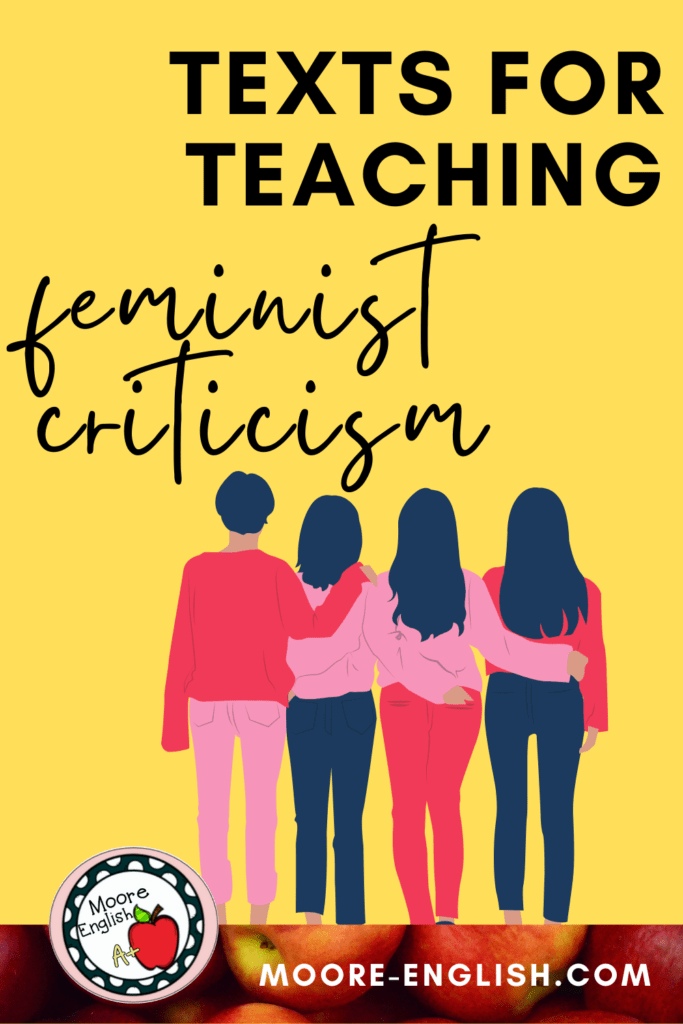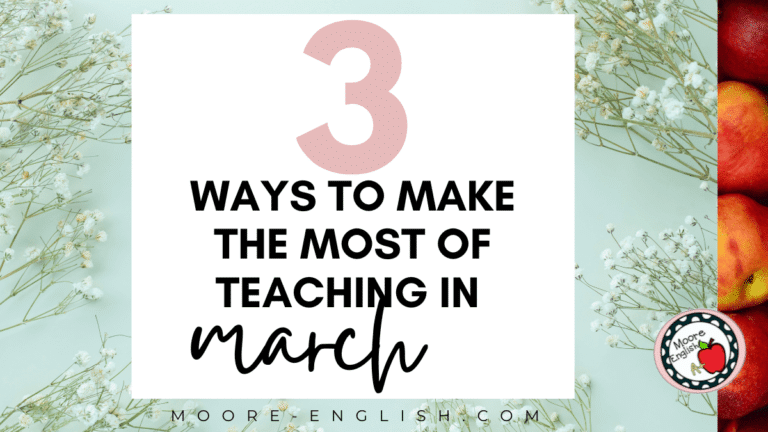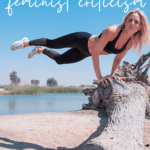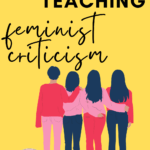When I introduce literary criticism to my students, feminist criticism is one of the first lenses we use.
In part, we encounter feminist criticism early on because students know the word “feminist” or “feminism” without always know what those terms mean. Unfortunately, some of my students often have negative attitudes toward “feminist” and “feminism.” Introducing feminist criticism helps students unpack those terms and better understand what it means to be a feminist.
Additionally, at the high school level, feminist criticism is fairly straightforward. When applying feminist criticism, we are basically looking at how a text treats its womxn characters. In other words, we’re asking the same three questions over and over:
- First, how does the text treat womxn characters?
- Similarly, what does the treatment of womxn characters reveal about the text, its author, or its historical context?
- Finally, does the treatment of womxn characters support or undermine the author’s purpose for writing? Why or why not?
Keep reading to check out 23 texts that help students answer these questions!
This post this post may contain affiliate links. Please read the Terms of Use.
Using Mythology to Introduce Feminist Criticism
Anytime I introduce a new critical lens, I like to start with a familiar text. Since literary criticism requires students to evaluate a text from a new angle, it’s helpful to begin with a low-stress text.
By the time students come to me, they have usually read The Odyssey, so that’s oftentimes a good place for us to begin applying literary criticism.
Firstly, I often begin with “Siren Song” by Margaret Atwood. For one, students usually remember Odysseus’ encounter with the sirens. (Even if they don’t, we can quickly re-read the scene here.) As we’re reading or recalling this scene, we can discuss how many of the womxn characters in The Odyssey are vilified, including Circe and Calypso. Then, to take our feminist criticism further, we can read “Siren Song”and evaluate how Atwood’s version of events is different from Homer’s original. To extend this lesson, teachers can do the same thing with the song “Calypso” by Suzanne Vega.
Penelope As a Focal Point for Feminist Criticism
Similarly, there are a variety of poems that reimagine Penelope’s role in The Odyssey. While students may not always remember Penelope, we can quickly remember her by reading Penelope, Penelope’s Suitors, and Penelope’s Test. Once students are more familiar with Penelope’s story, we can use feminist criticism to evaluate the source. Then, we can dive into some more modern reinterpretations of Penelope’s story.
- First, “Penelope” by Dorothy Parker is a short glimpse into Penelope’s days. This is a great place to begin applying literary criticism, especially since the poem’s first person provides key contrast to the original text. Read it here.
- Similarly, “Penelope to Ulysses” by Meredith Schwartz also uses the first person. The epistolary nature of this poem adds another layer of complexity. (Plus, teachers can build on this poem by having students write their own letters to Ulysses.) Read it here.
- Finally, “An Ancient Gesture” by Edna St. Vincent Millay is my favorite of these three poems because it modernizes Penelope’s struggle. Rather than focusing on Penelope, this poem focuses on how her story continues to be re-lived by other womxn today. This poem provides a good opportunity to connect the text to modern times. Read it here.
Grab all three of my resources for teaching these poems in The Odyssey Synthesis Bundle!
Helen as a Focal Point for Feminist Criticism
Like Penelope, Helen is a well-known figure in mythology. Unlike Penelope, fewer of my students are familiar with Helen, so using her as a focal point for feminist criticism is a way to begin leveling up.
- Firstly, “Helen of Troy” by Ella Wheeler Wilcox has a clear sonnet structure that students understand. For this reason, students can spend more time focused on a feminist reading of the poem. Read it here.
- Additionally, “Helen” by Nikita Gill is a student favorite! My students are often familiar with Gill’s work from social media, and her book Great Goddesses: Life Lessons from Myths and Monsters is always checked out from the classroom library. The question at the end of this poem makes it a great candidate for feminist criticism!
- Finally, “Helen” by H.D. is the most challenging of these texts because it is the most ambiguous. Once students have a grip on the poem, they can turn readily to feminist criticism, but they have to nail the poem’s meaning first. Read it here.
Teaching resources and lesson plans for all three of these poems are included in my 11-12 Synthesizing Allusion Across Media Bundle, which helps students synthesize across media by focusing on one central allusion.
Poetry to Teach Feminist Criticism
Beyond mythology, poetry is a good way to introduce feminist criticism. The brevity of poetry makes it an ideal medium for applying new skills and concepts. Here are some of my favorite poems for using feminist criticism:
Firstly, “The Latin Deli: An Ars Poetica” by Judith Ortiz Cofer is a good poem to begin with. While this is a longer poem, the language is fairly straightforward, so students can spend less time paraphrasing and more time applying feminist criticism. Read it here.
Secondly, “What I Carried” by Maggie Smith is another great poem for introducing feminist criticism. In this shorter poem, students have to grapple with feminist criticism in the context of motherhood. Another great Smith poem is “You Could Never Take a Car to Greenland.” Read them both in Good Bones, one of my favorite poetry collections.
Similarly, the one word in “One-Word Poem” by David R. Slavitt pairs nicely with either of Maggie Smith’s poems. This offers readers another perspective on motherhood, which is complicated by Slavitt writing the poem without every being a mother. Read it here.
As students become more comfortable with feminist criticism, they’re ready for more challenging poems. To my mind, that means poetry that’s complicated by sarcasm, understatement, and irony. Two great poems for this next level are “I Sit and Sew” by Alice Moore Dunbar-Nelson and “I, being born a woman and distressed” by Edna St. Vincent Millay. The first time we read these poems, my students almost always giggle a little. In other words, these are engaging poems for students.
Grab four of these poems in the Feminist Criticism Bundle!
Short Stories for Teaching Feminist Criticism
As students continue to develop their skills with feminist criticism, we move on to longer works. Short stories are great tools for literary criticism because they often lend themselves to more than one critical lens. Check out some of my favorite short stories for feminist criticism:
- Firstly, “A White Heron” by Sarah Orne Jewett is an English classroom staple. When my students are newer to literary criticism, I often choose this text because the plot is fairly simple, but the text lends itself to several critical lenses, including Marxist and feminist criticism. Read it here.
- Similarly, “The Yellow Wall-Paper” by Charlotte Perkins Gilman is a popular text for American literature. Since this text is a little longer and more complex than “A White Heron,” it’s a great level up for students. When teachers couple this short story with the essay “Why I Wrote ‘The Yellow Wall-paper’?”, students have the chance to practice biographical and feminist criticism. Read the short story here.
- In contrast to the sympathetic protagonists in Jewett and Perkins Gilman’s work, the protagonist of “Editha” by William Dean Howells is not sympathetic. As such, this short story provides a greater challenge to students as they read and annotate. Additionally, this is the first short story recommendation that doesn’t come from a womxn author, which will complicate students’ classroom conversation. Read it here.
Increased Complexity for Criticism
- Additionally, the protagonist in “Girl” by Jamaica Kincaid is sympathetic while the speaker is not. While this story is short, its structure is more complex. Like “What I Carried,” this story also introduces the relationship between mother and daughter. Overall, this text requires a nuanced approach to feminist criticism. Read it here.
- Next, “Berenice” by Edgar Allan Poe is named after the woman character, but she’s not the speaker nor is she given much agency. As with Howells’ story, the feminist criticism here is complicated by Poe’s writing. Furthermore, the horrifying nature of this text makes it a hard read in some ways. Check it out here.
- Finally, my favorite short story on this list is “A New England Nun” by Mary E. Freeman. This is such a great read for several types of literary criticism, including Marxist, deconstructionist, and feminist criticism. Overall, the end of this short story makes it a must-read. Check it out here.
To help you bring all of these short stories into your classroom, I’ve put together a 9-12 Short Stories bundle that will save you time and money!
Longer Works for Teaching Feminist Criticism
As students become more adept at literary criticism, they can begin evaluating longer and more complex works.
Oftentimes when teachers think of longer works, we think of novels. While I do have some novel recommendations, dramas are also an amazing tool for literary criticism. Because drama is performed, it really lends itself to the kind of dialogue in which literary criticism thrives. Check out these three dramas for incorporating feminist criticism:
- Firstly, many English teachers first think of Lady Macbeth when considering womxn in drama. Indeed, Macbeth by William Shakespeare is a great opportunity for feminist criticism.
- Similarly, Julius Caesar is another Shakespearean drama ripe for literary criticism! The fact that there are so few womxn characters in this text provides students with a great sense of focus.
- If Shakespeare is not the dramatist for you, The Crucible by Arthur Miller is a good play for applying literary criticism. The treatment of Elizabeth Proctor and Abigail Williams makes for strong discussion.
Beyond classroom dramas, novels are always a good place to apply literary criticism. In this case, my two recommendations are diametrically different.
- Firstly, The Great Gatsby by F. Scott Fitzgerald features womxn characters who are not empowered. When the womxn characters in the text do have agency, it’s always coupled with wealth and privilege. Reading this novel alongside Fitzgerald’s short story “Winter Dreams” also provides a rich conversation about how Fitzgerald treats womxn characters.
- On the other hand, Pride and Prejudice by Jane Austen features womxn characters with varied levels of privilege and agency. The diverse motivations of the womxn characters also factors into classroom conversations about feminist criticism.
Further Reading
Since literary criticism is one of my passions, I’ve written quite a bit about it. Check out these related posts and resources:
- 5 Reasons to Include Literary Criticism, and 5 Ways to Make it Happen
- How to Introduce Deconstructionist Literary Criticism
- Teaching at the Intersection of History and Literature
- 8 Ways to Bring Creativity into the Classroom
- 40 Texts for Teaching Literary Criticism
- Historical and Biographical Criticism
- Deconstructionist Criticism Bundle
- All Literary Criticism Resources
- Introducing Literary Criticism
- Feminist Criticism Bundle
- Historical Criticism


















